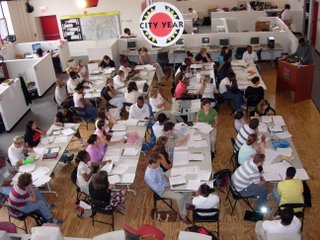Wednesday, October 25, 2006
Basic Training Academy: Immersion Excursion

The first month of the service year for a new City Year corps member is Basic Training Academy (or BTA in City Year lingo). We participate in trainings for pretty much anything and everything we will face during our year of service. Some of the trainings include “Introduction to Washington, DC and its History,” “Behavior Management in a Classroom,” and many team-specific trainings such as how to deliver our HIV/AIDS “Making Proud Choices” curriculum to middle and high school students.
My favorite training this year was the “Immersion Excursion.” In groups, corps members explored two DC neighborhoods to talk with residents and learn more about those specific communities. It’s the first chance corps members have to walk around and learn more about the neighborhoods they will be serving in. Before leaving the office, the facilitator talked about how DC is a city divided between the haves and have-nots. My group’s exploration of the Northeast neighborhoods around the Brookland/CUA Metro Station and the next metro station at Rhode Island Avenue made that comparison very clear. Catholic and Trinity Universities are both located near the Brookland/CUA Metro Station. Most of the green areas around the roads and sidewalks are well-maintained. There are also a number of small restaurants and cafés catering to the college students, who were mostly white. A corps member in my group was a DC native, who had spent significant time in Northeast Washington. He walked us through some residential streets and showed us that the area right around the Brookland/CUA Metro Station reflects and caters to the college community and not to the overall neighborhood and its residents. The neighborhood around the Rhode Island Avenue Station was different and in contrast to the area around the Brookland/CUA Metro Station. Rhode Island Avenue is a major traffic artery that runs through Northeast Washington. There was noticeably more trash and less upkeep around the roads and sidewalks compared to the first neighborhood we visited. There was a large strip mall with a grocery store, dollar store, clothing store, etc. We spoke with a resident who had lived in the neighborhood over 15 years and said, “The most pressing need here is having things for kids to do after school. When kids or teenagers have too much unstructured free time and outlets for constructive uses of their time are not available, they are more likely to get persuaded to get into trouble.” Even though it was comforting to know that a significant portion of CYDC’s (City Year Washington DC) service is in after-school programs around the District, simply the surface differences between two communities so near one another was unsettling.